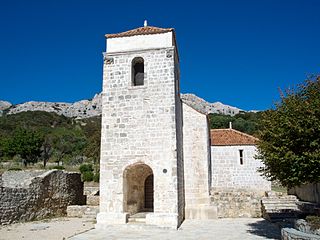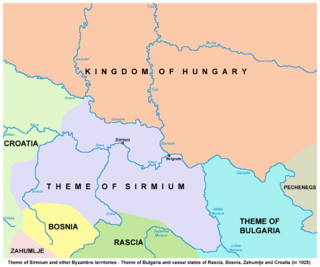 W
WBaška tablet is one of the first monuments containing an inscription in the Croatian recension of the Church Slavonic language, dating from c. 1100 AD.
 W
WThe Church of St. Lucy in Jurandvor near Baška, Krk, Croatia is a Romanesque Catholic church from the year 1100 with two major medieval Croatian artifacts: the Baška Tablet, and a checkerboard-pattern carving on the bell tower that is suspected to be one of the first instances of the Croatian coat of arms.
 W
WThe Kingdom of Croatia, or Croatian Kingdom, was a medieval kingdom in Central Europe comprising most of what is today Croatia, as well as most of the modern-day Bosnia and Herzegovina. The Croatian Kingdom was ruled for part of its existence by ethnic dynasties, and the Kingdom existed as a sovereign state for nearly two centuries. Its existence was characterized by various conflicts and periods of peace or alliance with the Bulgarians, Byzantines, Hungarians, and competition with Venice for control over the eastern Adriatic coast. The goal of promoting the Croatian language in the religious service was initially introduced by the 10th century bishop Gregory of Nin, which resulted in a conflict with the Pope, later to be put down by him. In the second half of the 11th century Croatia managed to secure most coastal cities of Dalmatia with the collapse of Byzantine control over them. During this time the kingdom reached its peak under the rule of kings Peter Krešimir IV (1058–1074) and Demetrius Zvonimir (1075–1089).
 W
WInscription of Župa Dubrovačka is a Glagolitic inscription dated to the 11th century.
 W
WThe Croatian interlace or Croatian wattle, known as the pleter or troplet in Croatian, is a type of interlace, most characteristic for its three-ribbon pattern. It is one of the most often used patterns of pre-romanesque Croatian art. It is found on and within churches as well as monasteries built in early medieval Kingdom of Croatia between the 9th and beginning of the 12th century. The ornamental strings were sometimes grouped together with animal and herbal figures.
 W
WPlomin tablet is a Glagolitic inscription in Croatian at the outer wall of the church of Saint George in Plomin, modern-day Croatia. Roman god of flora and fauna Silvanus is portrayed. This inscription bears witness of early parallelism of two cultural currents on Istrian territory: Romance symbol is an Antique relief, and Slavic, i.e. Croatian symbol is the Croatian language and Glagolitic script.
 W
WThe Theme of Sirmium was a Byzantine administrative unit (theme), which existed in present-day Serbia, Croatia and Bosnia and Herzegovina in the 11th century. Its capital was Sirmium.
 W
WThe Valun tablet is an 11th-century bilingual and digraphic tablet, originally serving the role of a gravestone, found at the graveyard in Valun on the island of Cres. It records that under the tablet three generations of one 11th-century Valun family rest in peace: the grandmother, her son and grandson. Today, the Valun tablet is embedded in the wall of Saint Mary in Valun. Its bilinguality is important evidence of the coexistence of two ethnic and linguistic elements: old Romance and newly arrived Croatian.